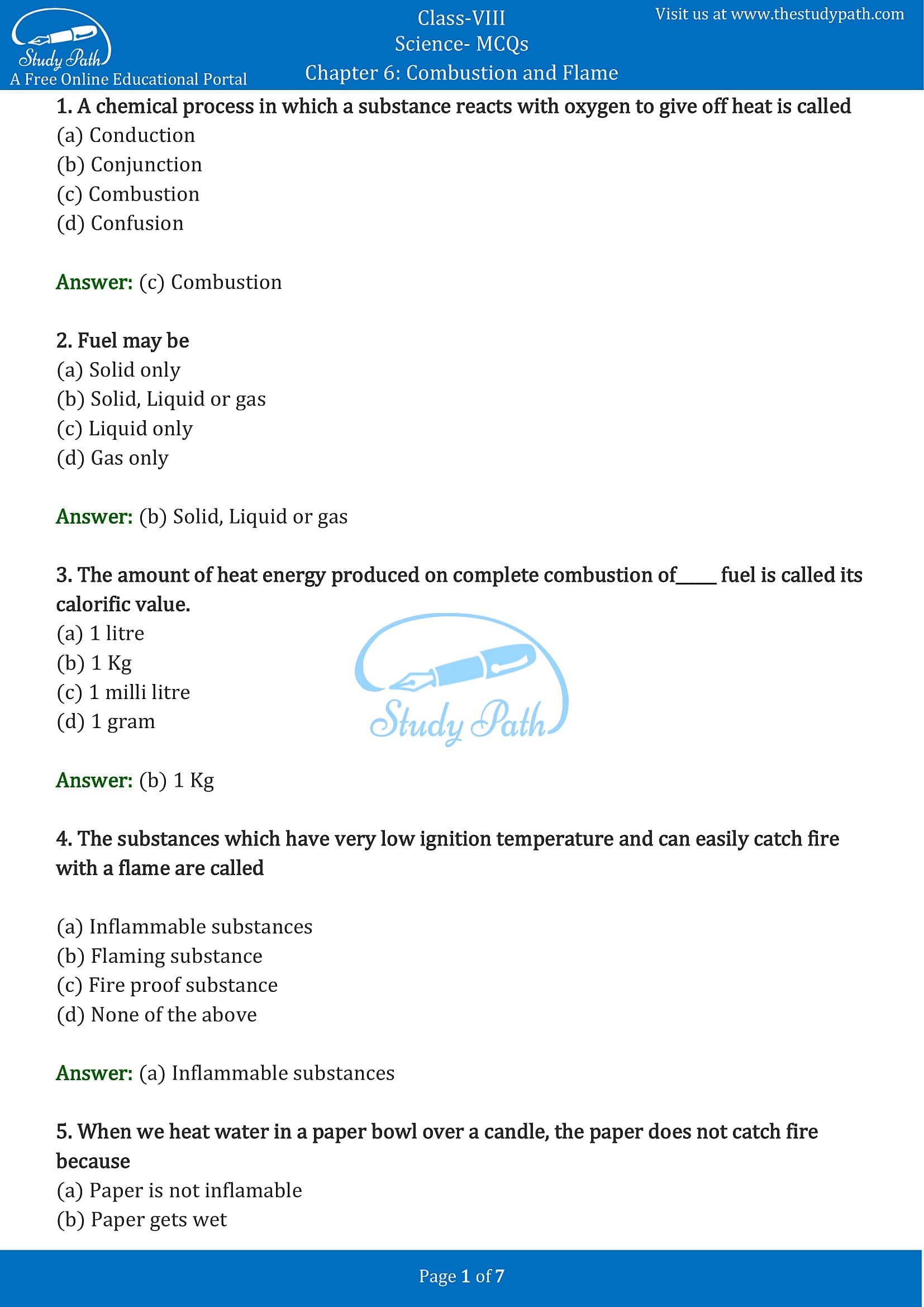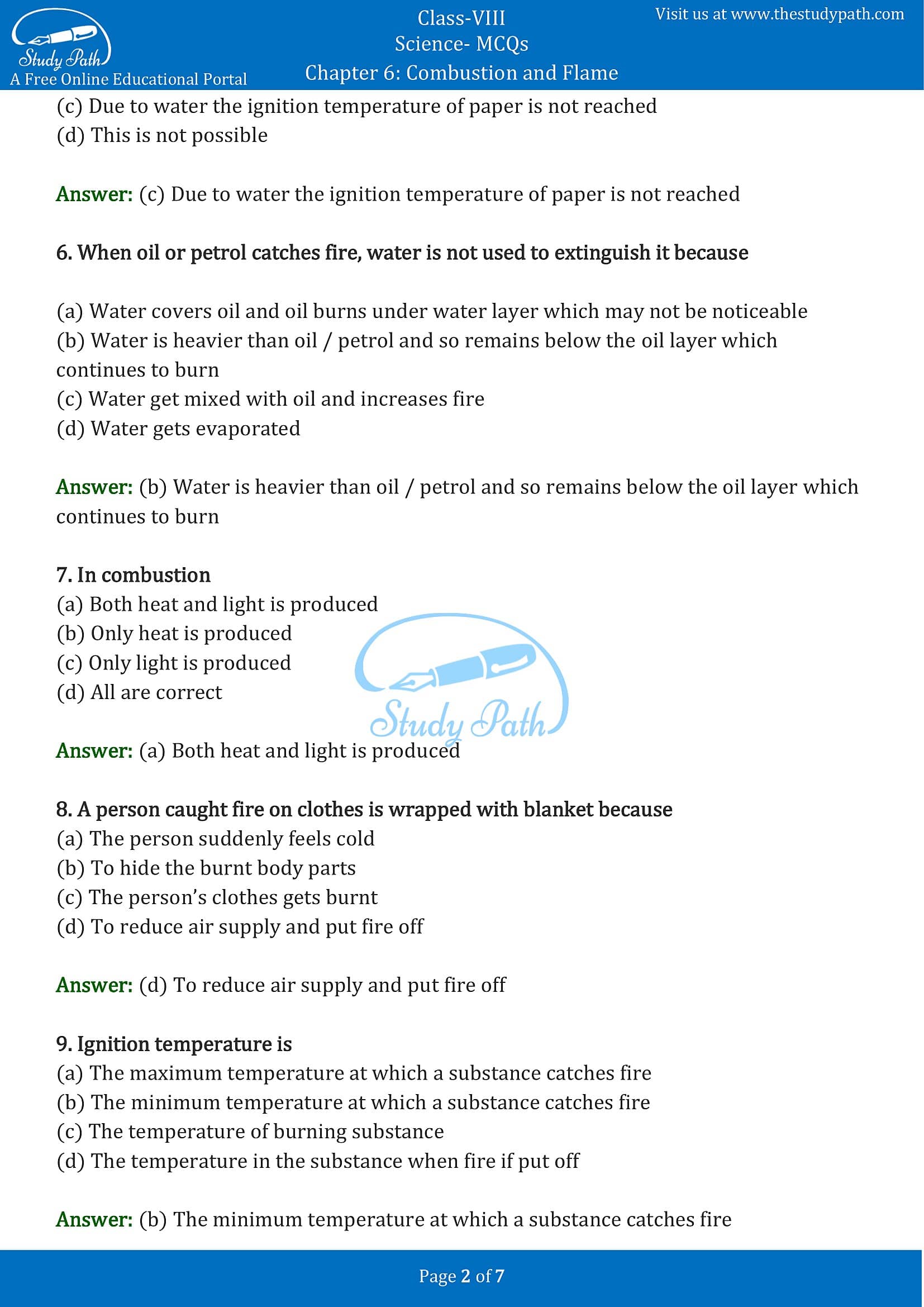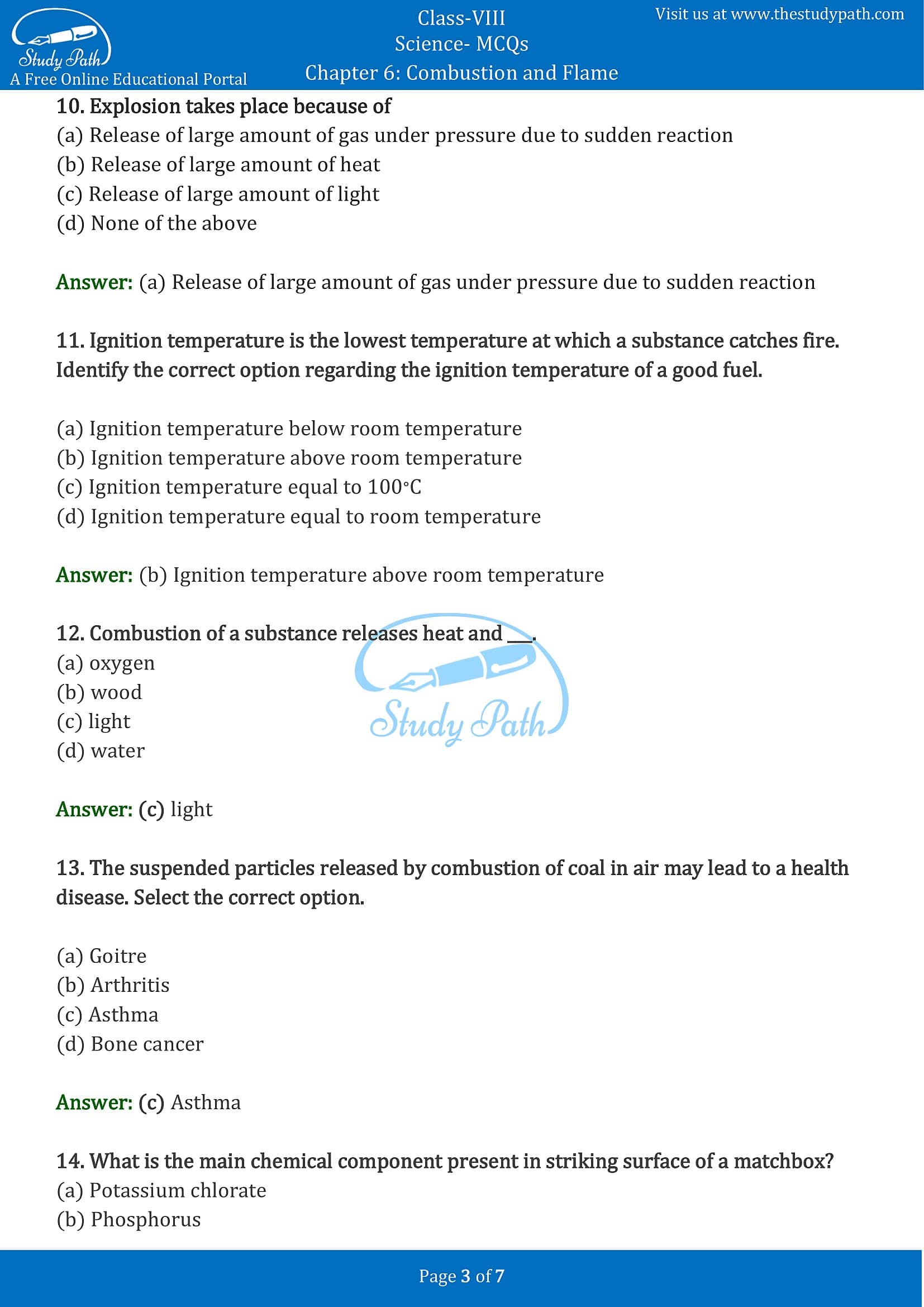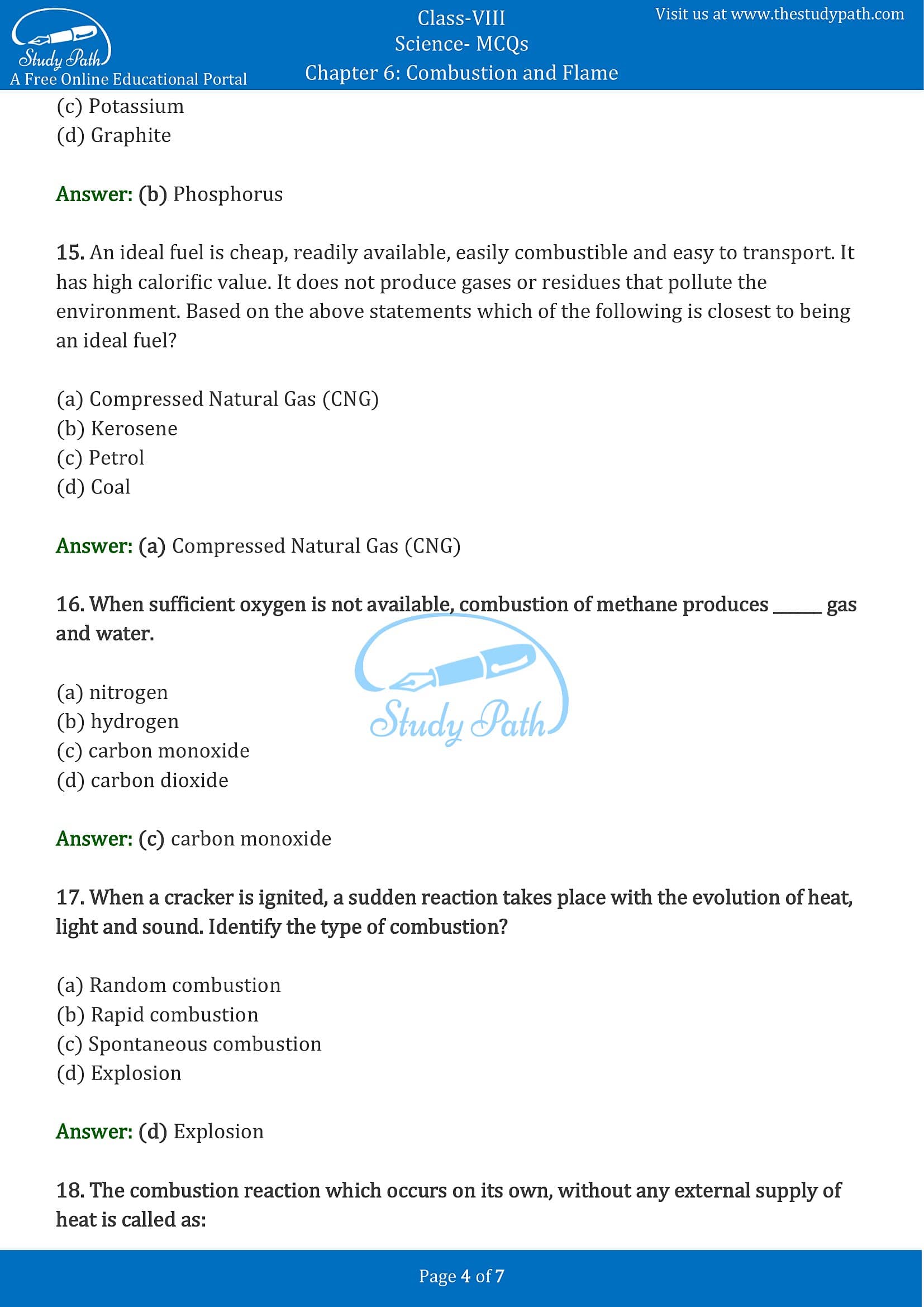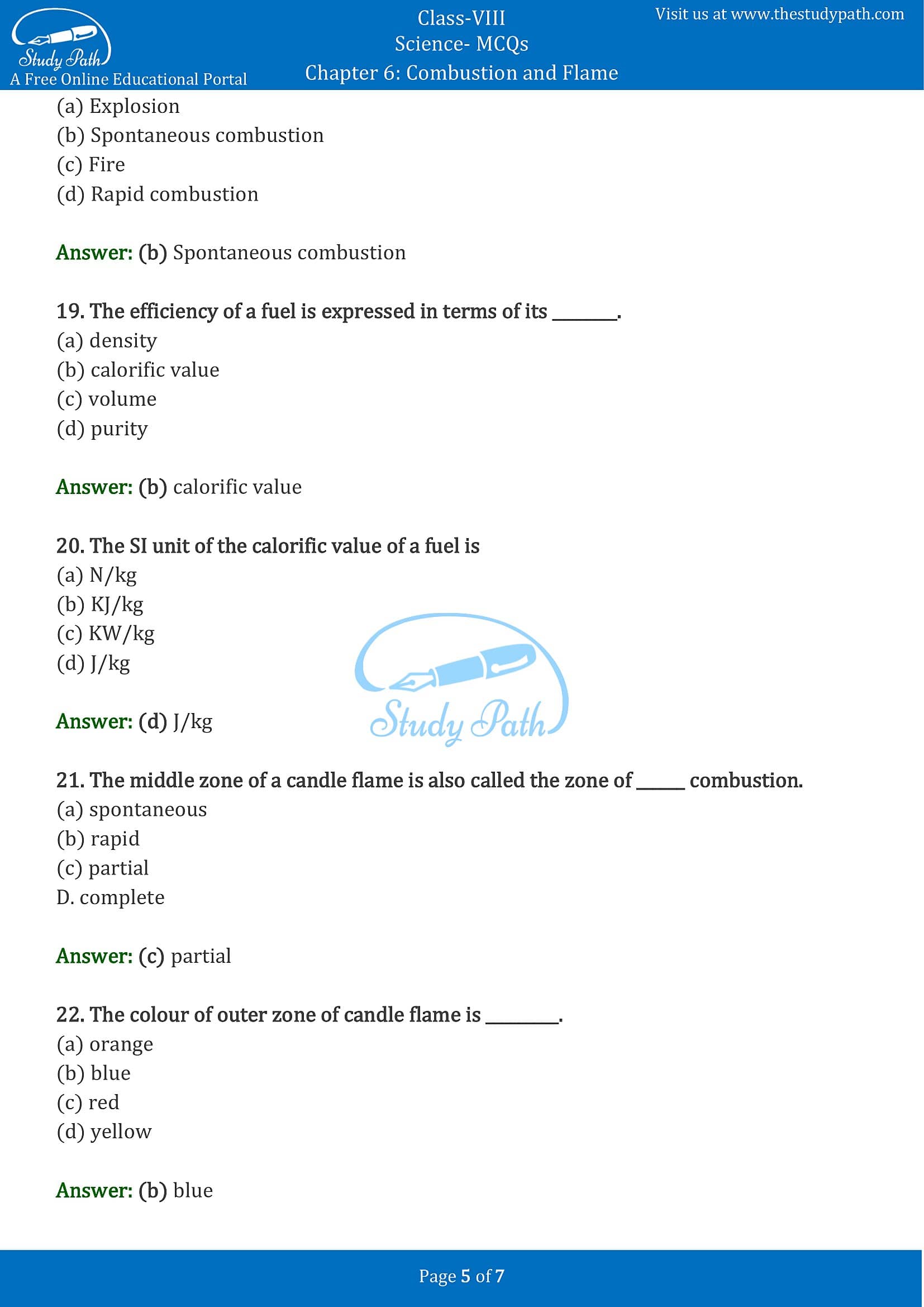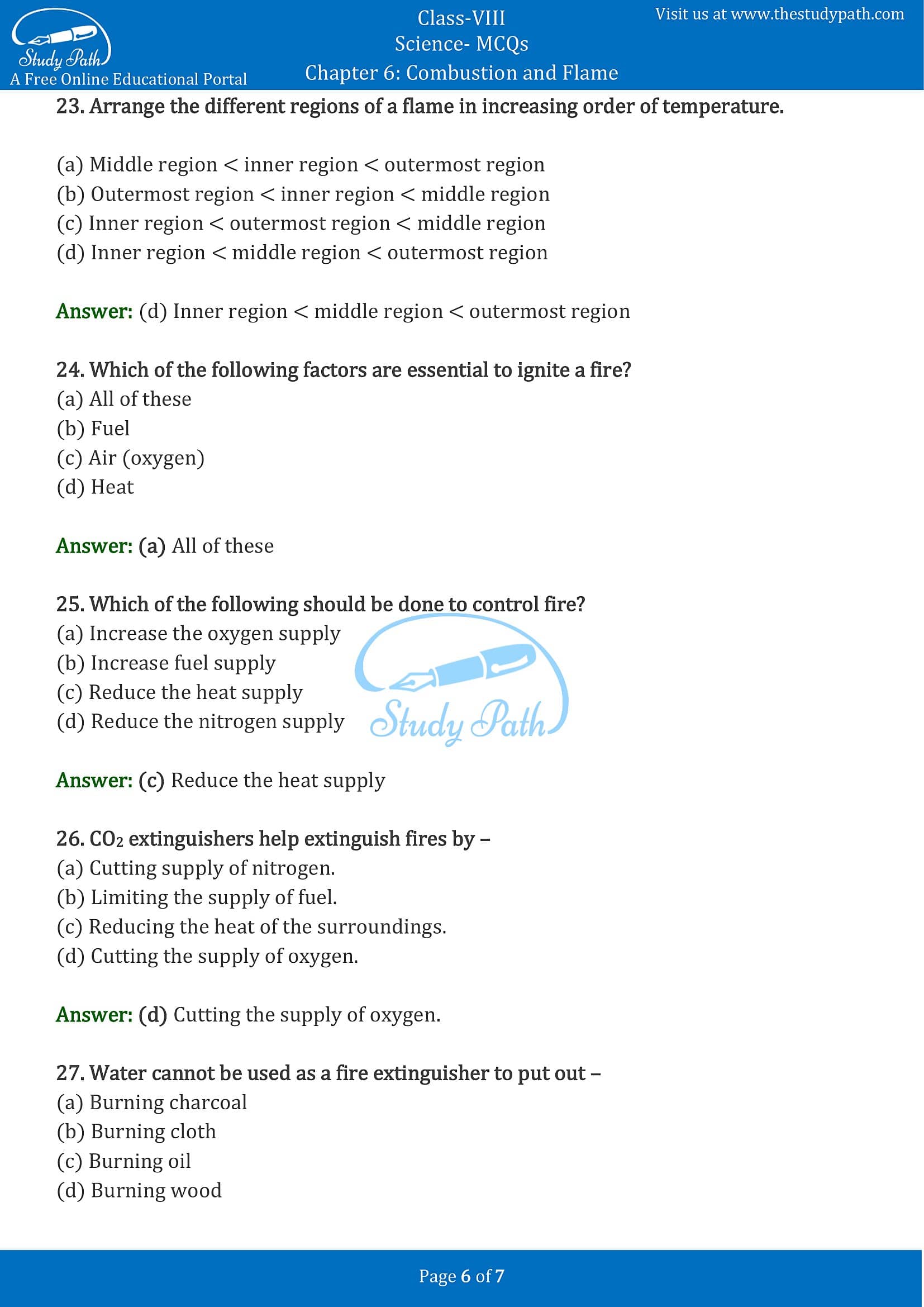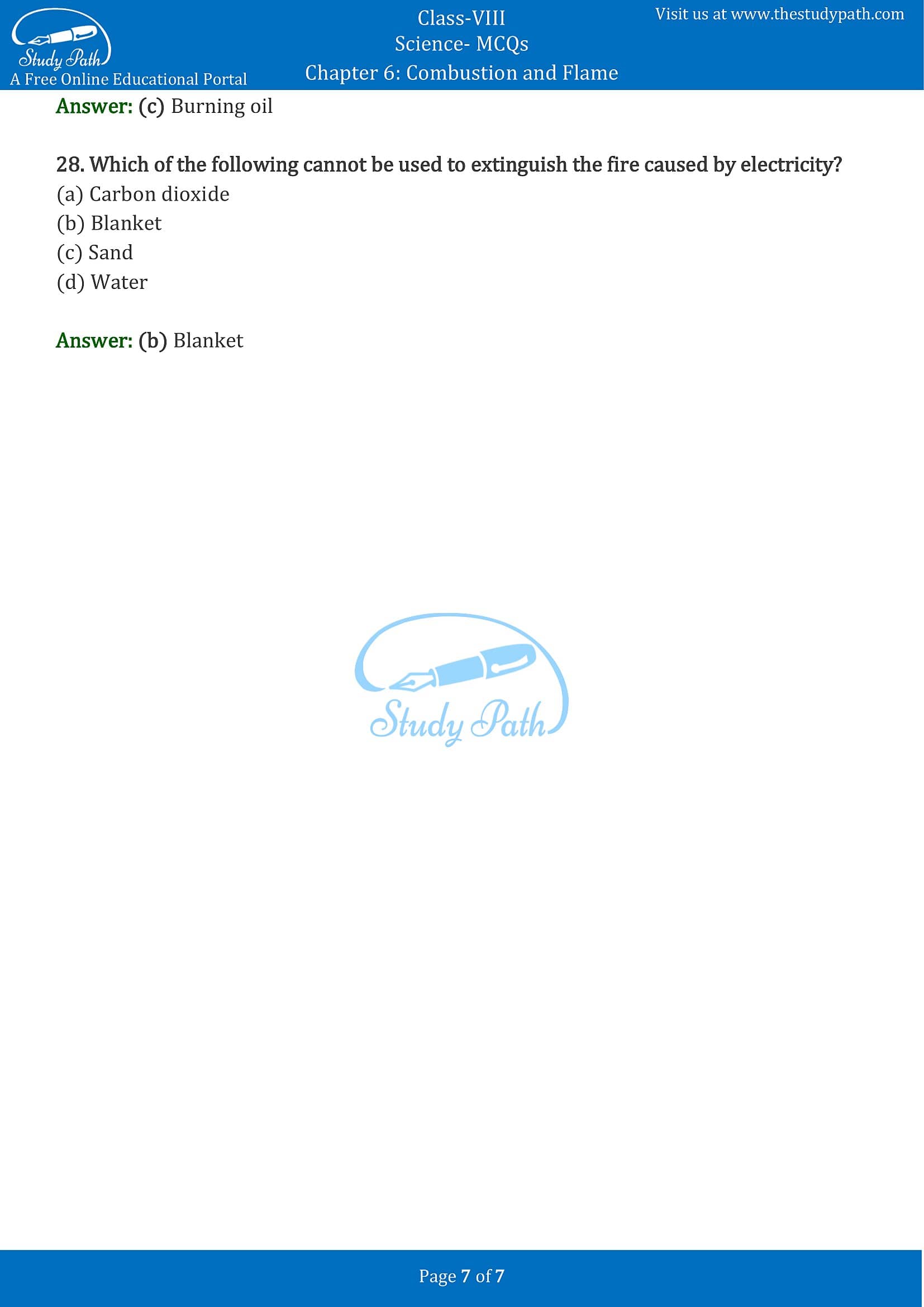Class 8 Science Chapter 6 Combustion and Flame MCQ with Answers
Class 8 Science Chapter 6 Combustion and Flame MCQ (Multiple Choice Questions) with Answers is available here in PDF format. CBSE Class 8 Science Combustion and Flame NCERT Objective Questions helps the students to understand the concepts thoroughly and to score good marks. Practising these MCQs will help you to answer every question that is being asked in the exams. Students can solve these MCQs to know their preparation level.
Combustion and Flame Class 8 MCQ with Answers
Multiple Choice Questions (MCQs)
1. A chemical process in which a substance reacts with oxygen to give off heat is called
(a) Conduction
(b) Conjunction
(c) Combustion
(d) Confusion
Answer: (c) Combustion
2. Fuel may be
(a) Solid only
(b) Solid, Liquid or gas
(c) Liquid only
(d) Gas only
Answer: (b) Solid, Liquid or gas
3. The amount of heat energy produced on complete combustion of_____ fuel is called its calorific value.
(a) 1 litre
(b) 1 Kg
(c) 1 millilitre
(d) 1 gram
Answer: (b) 1 Kg
4. The substances which have very low ignition temperature and can easily catch fire with a flame are called
(a) Inflammable substances
(b) Flaming substance
(c) Fire proof substance
(d) None of the above
Answer: (a) Inflammable substances
5. When we heat water in a paper bowl over a candle, the paper does not catch fire because
(a) Paper is not inflamable
(b) Paper gets wet
(c) Due to water the ignition temperature of paper is not reached
(d) This is not possible
Answer: (c) Due to water the ignition temperature of paper is not reached
6. When oil or petrol catches fire, water is not used to extinguish it because
(a) Water covers oil and oil burns under water layer which may not be noticeable
(b) Water is heavier than oil / petrol and so remains below the oil layer which continues to burn
(c) Water get mixed with oil and increases fire
(d) Water gets evaporated
Answer: (b) Water is heavier than oil / petrol and so remains below the oil layer which continues to burn
7. In combustion
(a) Both heat and light is produced
(b) Only heat is produced
(c) Only light is produced
(d) All are correct
Answer: (a) Both heat and light is produced
8. A person caught fire on clothes is wrapped with blanket because
(a) The person suddenly feels cold
(b) To hide the burnt body parts
(c) The person’s clothes gets burnt
(d) To reduce air supply and put fire off
Answer: (d) To reduce air supply and put fire off
9. Ignition temperature is
(a) The maximum temperature at which a substance catches fire
(b) The minimum temperature at which a substance catches fire
(c) The temperature of burning substance
(d) The temperature in the substance when fire if put off
Answer: (b) The minimum temperature at which a substance catches fire
10. Explosion takes place because of
(a) Release of large amount of gas under pressure due to sudden reaction
(b) Release of large amount of heat
(c) Release of large amount of light
(d) None of the above
Answer: (a) Release of large amount of gas under pressure due to sudden reaction
11. Ignition temperature is the lowest temperature at which a substance catches fire. Identify the correct option regarding the ignition temperature of a good fuel.
(a) Ignition temperature below room temperature
(b) Ignition temperature above room temperature
(c) Ignition temperature equal to 100∘C
(d) Ignition temperature equal to room temperature
Answer: (b) Ignition temperature above room temperature
12. Combustion of a substance releases heat and ___.
(a) oxygen
(b) wood
(c) light
(d) water
Answer: (c) light
13. The suspended particles released by combustion of coal in air may lead to a health disease. Select the correct option.
(a) Goitre
(b) Arthritis
(c) Asthma
(d) Bone cancer
Answer: (c) Asthma
14. What is the main chemical component present in striking surface of a matchbox?
(a) Potassium chlorate
(b) Phosphorus
(c) Potassium
(d) Graphite
Answer: (b) Phosphorus
15. An ideal fuel is cheap, readily available, easily combustible and easy to transport. It has high calorific value. It does not produce gases or residues that pollute the environment. Based on the above statements which of the following is closest to being an ideal fuel?
(a) Compressed Natural Gas (CNG)
(b) Kerosene
(c) Petrol
(d) Coal
Answer: (a) Compressed Natural Gas (CNG)
16. When sufficient oxygen is not available, combustion of methane produces ______ gas and water.
(a) nitrogen
(b) hydrogen
(c) carbon monoxide
(d) carbon dioxide
Answer: (c) carbon monoxide
17. When a cracker is ignited, a sudden reaction takes place with the evolution of heat, light and sound. Identify the type of combustion?
(a) Random combustion
(b) Rapid combustion
(c) Spontaneous combustion
(d) Explosion
Answer: (d) Explosion
18. The combustion reaction which occurs on its own, without any external supply of heat is called as:
(a) Explosion
(b) Spontaneous combustion
(c) Fire
(d) Rapid combustion
Answer: (b) Spontaneous combustion
19. The efficiency of a fuel is expressed in terms of its ________.
(a) density
(b) calorific value
(c) volume
(d) purity
Answer: (b) calorific value
20. The SI unit of the calorific value of a fuel is
(a) N/kg
(b) KJ/kg
(c) KW/kg
(d) J/kg
Answer: (d) J/kg
21. The middle zone of a candle flame is also called the zone of ______ combustion.
(a) spontaneous
(b) rapid
(c) partial
(d) complete
Answer: (c) partial
22. The colour of outer zone of candle flame is _________.
(a) orange
(b) blue
(c) red
(d) yellow
Answer: (b) blue
23. Arrange the different regions of a flame in increasing order of temperature.
(a) Middle region < inner region < outermost region
(b) Outermost region < inner region < middle region
(c) Inner region < outermost region < middle region
(d) Inner region < middle region < outermost region
Answer: (d) Inner region < middle region < outermost region
24. Which of the following factors are essential to ignite a fire?
(a) All of these
(b) Fuel
(c) Air (oxygen)
(d) Heat
Answer: (a) All of these
25. Which of the following should be done to control fire?
(a) Increase the oxygen supply
(b) Increase fuel supply
(c) Reduce the heat supply
(d) Reduce the nitrogen supply
Answer: (c) Reduce the heat supply
26. CO2 extinguishers help extinguish fires by –
(a) Cutting supply of nitrogen.
(b) Limiting the supply of fuel.
(c) Reducing the heat of the surroundings.
(d) Cutting the supply of oxygen.
Answer: (d) Cutting the supply of oxygen.
27. Water cannot be used as a fire extinguisher to put out –
(a) Burning charcoal
(b) Burning cloth
(c) Burning oil
(d) Burning wood
Answer: (c) Burning oil
28. Which of the following cannot be used to extinguish the fire caused by electricity?
(a) Carbon dioxide
(b) Blanket
(c) Sand
(d) Water
Answer: (b) Blanket
At Study Path, you can also learn more about science chapter 6 Combustion and Flame by accessing the free exhaustive list of study materials and resources related to the chapter such as NCERT Solutions, Important Questions and Extra Questions.
